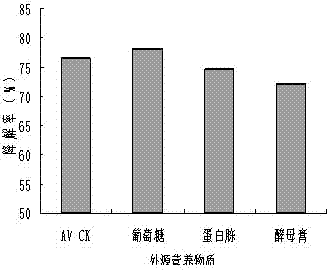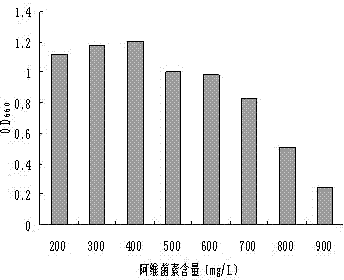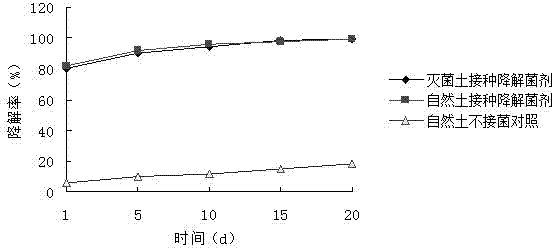Avermectin pesticide residual degrading bacterium, and microbial inoculum produced thereby
A technology for pesticide residue degradation and abamectin, applied in the direction of microorganism-based methods, bacteria, microorganisms, etc., can solve the problems of abamectin residue degradation agent products, etc., to improve the quality of agricultural products, easy to use, and low cost Effect
- Summary
- Abstract
- Description
- Claims
- Application Information
AI Technical Summary
Problems solved by technology
Method used
Image
Examples
Embodiment 1
[0024] Embodiment 1: the isolation of degrading bacterial strain
[0025] Take 10g of abamectin fermentation waste residue sample and add it into a conical flask filled with 90mL sterile water (250mL size, glass beads inside). Shake for 15 minutes, after static clarification, take 1 mL of supernatant and add 99 mL of basal medium, place them in incubators at 40°C, 50°C, and 60°C respectively, and culture with shaking at 150r / min. 3 days as a cycle for acclimatization, a total of 5 cycles, the concentration of abamectin is set as: 25mg / L, 50mg / L, 100mg / L, 150mg / L, 200mg / L, gradually increasing in each acclimation cycle. Each acclimatization medium was mixed with 10 -1 、10 -2 and 10 -3 Spread the basic medium plate (as a control) and the selective medium plate containing abamectin at dilution, select a single colony that grows fast and can use abamectin as the sole carbon source for further isolation and purification, until there is a single colony Appear.
[0026] After ...
Embodiment 2
[0029] Embodiment 2: bacterial strain AZ11 is to the degradation activity of abamectin
[0030] The abamectin efficient degrading strain AZ11 was cultured in liquid fermentation at 40°C and 150r / min, and the number of bacteria was adjusted to 10 9 cfu / mL, made into bacterial suspension. Add 10g / L glucose, peptone and yeast extract to the basal salt medium containing 100mg / L abamectin to study the effect of adding exogenous nutrients on the degradation of abamectin by AZ11, inoculate at 1% Bacterial suspension, cultured for 48h after sampling to determine the content of abamectin in the sample. In addition, add abamectin solution to the basal salt medium (with 500 mg / L glucose) to make the concentration to 100, 200, 300, 400, 500, 600 and 700 mg / L, and inoculate AZ11 with 1% inoculum Bacterial suspension, cultured at 50°C for 36 hours, then sampled to determine OD 660 value, to study the tolerance of strain AZ11 to abamectin.
[0031] Results from figure 1It can be seen...
Embodiment 3
[0033] Embodiment 3: the preparation of avermectin pesticide residue degradation bacterial agent
[0034] Activate the slant-preserved species of abamectin-degrading bacterium AZ11, inoculate it in LB liquid medium, shake it at 40-45°C to the logarithmic growth phase, inoculate the seed fermentation tank, and the formula of the seed fermentation tank is: corn flour 2%; Bean cake powder 1%; glucose 0.5%; K 2 HPO 4 0.4%; MgSO 4 ·7H 2 O 0.02%; CaCO 3 0.2%; pH 7.2-7.5. Autoclaved at 121°C, and when cooled to about 45°C, inoculate 10% of the cultured strain in the shake flask into a 10L seed tank, and cultivate to the logarithmic growth phase. The fermented liquid of the seed fermenter was inoculated into the production fermenter with 10% inoculum, and the medium formula was: corn flour 3%; bean cake flour 2%; CaCO 3 0.5%;K 2 HPO 4 0.2%; ZnSO 4 ·5H 2 O 0.05%; MgSO 4 ·7H 2 O 0.05%; pH 7.2;
[0035] The culture conditions of the above fermentation tanks are: culture...
PUM
 Login to View More
Login to View More Abstract
Description
Claims
Application Information
 Login to View More
Login to View More - R&D
- Intellectual Property
- Life Sciences
- Materials
- Tech Scout
- Unparalleled Data Quality
- Higher Quality Content
- 60% Fewer Hallucinations
Browse by: Latest US Patents, China's latest patents, Technical Efficacy Thesaurus, Application Domain, Technology Topic, Popular Technical Reports.
© 2025 PatSnap. All rights reserved.Legal|Privacy policy|Modern Slavery Act Transparency Statement|Sitemap|About US| Contact US: help@patsnap.com



